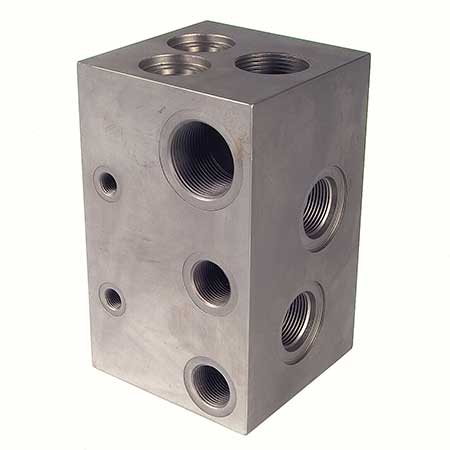Dura-Bar: An Alternative to Aluminum
Overview
The major problem with aluminum is that it normally cannot stand up to pressures of more than 3,000 psi. For example, cracks may start appearing in manifolds at port connections and/or within the walls between port openings.
The pressure rating for a manifold made from Dura-Bar can be more than three times higher than an aluminum manifold with the same design. To compensate for aluminum's lesser fatigue strength, design engineers often have to create systems with larger manifolds, which can present design challenges and negate any weight advantage that aluminum might hold over ductile iron.
The aluminum alloys most commonly used for hydraulic manifolds are 2024-T3 and 6061-T6. Both 2024 and 6061 are precipitation hardened (aged) alloys which means their strength is derived from heating the material and holding at a high temperature for an extended time. This tempering process changes the molecular structure of the aluminum and increases its tensile strength.
As is apparent from the mechanical properties listed in the table, the fatigue strength of Dura-Bar 65-45-12 ductile iron is more than double that of aluminum. Another important Dura-Bar advantage involves the elastic modulus, which is dramatically higher than that for aluminum. That means that, under the same load, aluminum will deflect or distort more than twice as much as 65-45-12. Deflection and distortion can cause fittings to loosen and can affect the overall alignment of critical components.
Given Dura-Bar's superiority over aluminum, opportunities for conversions to Dura-Bar will continue to abound, especially in situations where design engineers are pressured by their customers to develop more compact systems that operate at higher degrees of efficiency.

Cutaway of a manifold made from Dura-Bar as-machined, no deburring required.
Material Properties of Aluminum vs Dura-Bar 65-45-12 Ductile Iron
| Material Property | 6061-T6 | 2024-T3 | 65-45-12 |
|---|---|---|---|
| Hardness (BHN) | 95 | 120 | 180 |
| Tensile Strength (psi) | 45,000 | 70,000 | 65,000 |
| Yield Strength (psi) | 40,000 | 50,000 | 45,000 |
| Elongation (%) | 12 | 19 | 12 |
| Elastic Modulus (psi) | 10,000,000 | 10,600,000 | 25,000,000 |
| Fatigue Strength (psi) | 14,000 | 20,000 | 40,000 |
| Density (lbs./in3) | 0.098 | 0.1 | 0.255 |
| Thermal Expansion (micro-in/in/F) | 13.1 | 12.9 | 5.5 |
Example Application: Manifold
Aluminum's Problems
- Material not capable of withstanding high pressure
- Deburring
Solutions and Benefits
- Dura-Bar is pressure rated 6,500psi
- Little or no deburring
